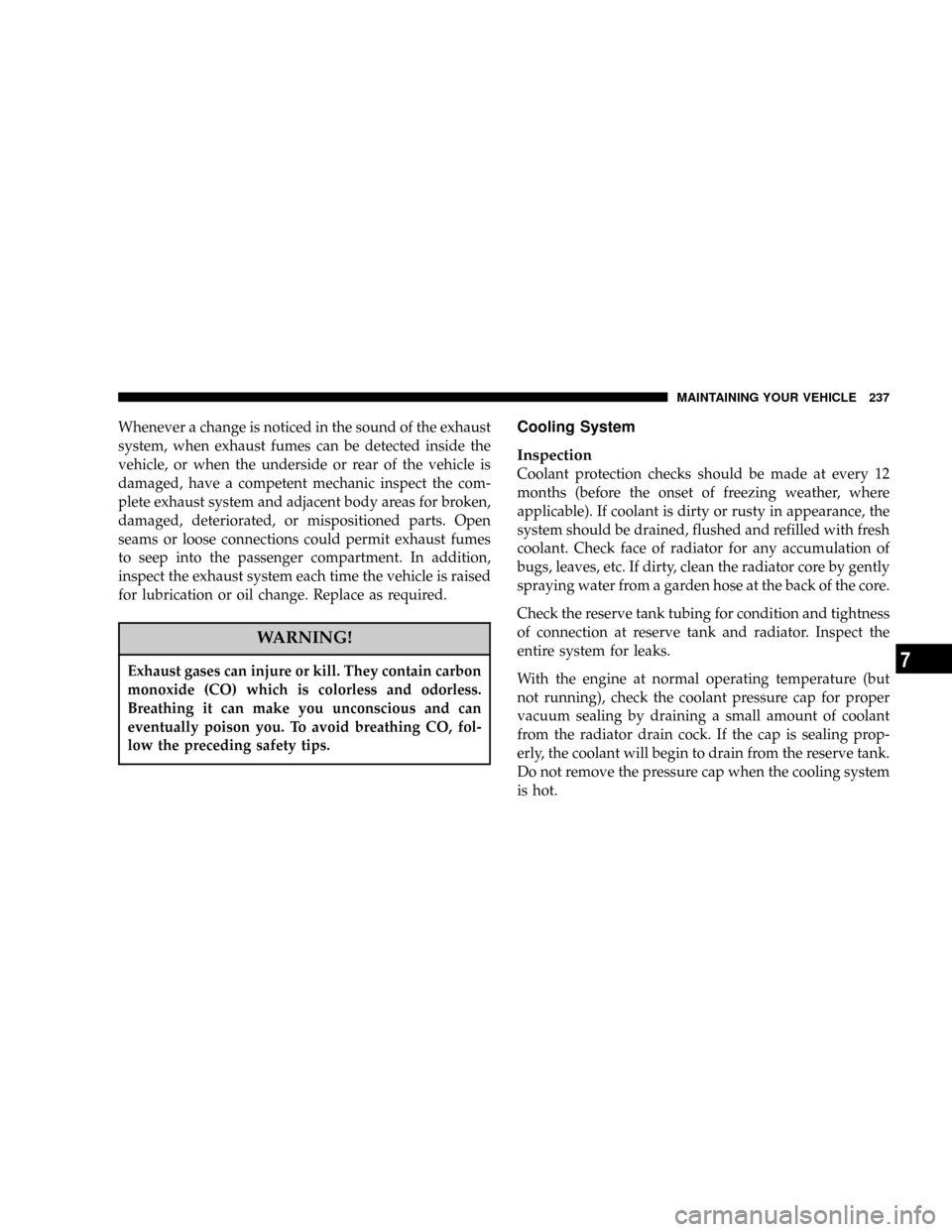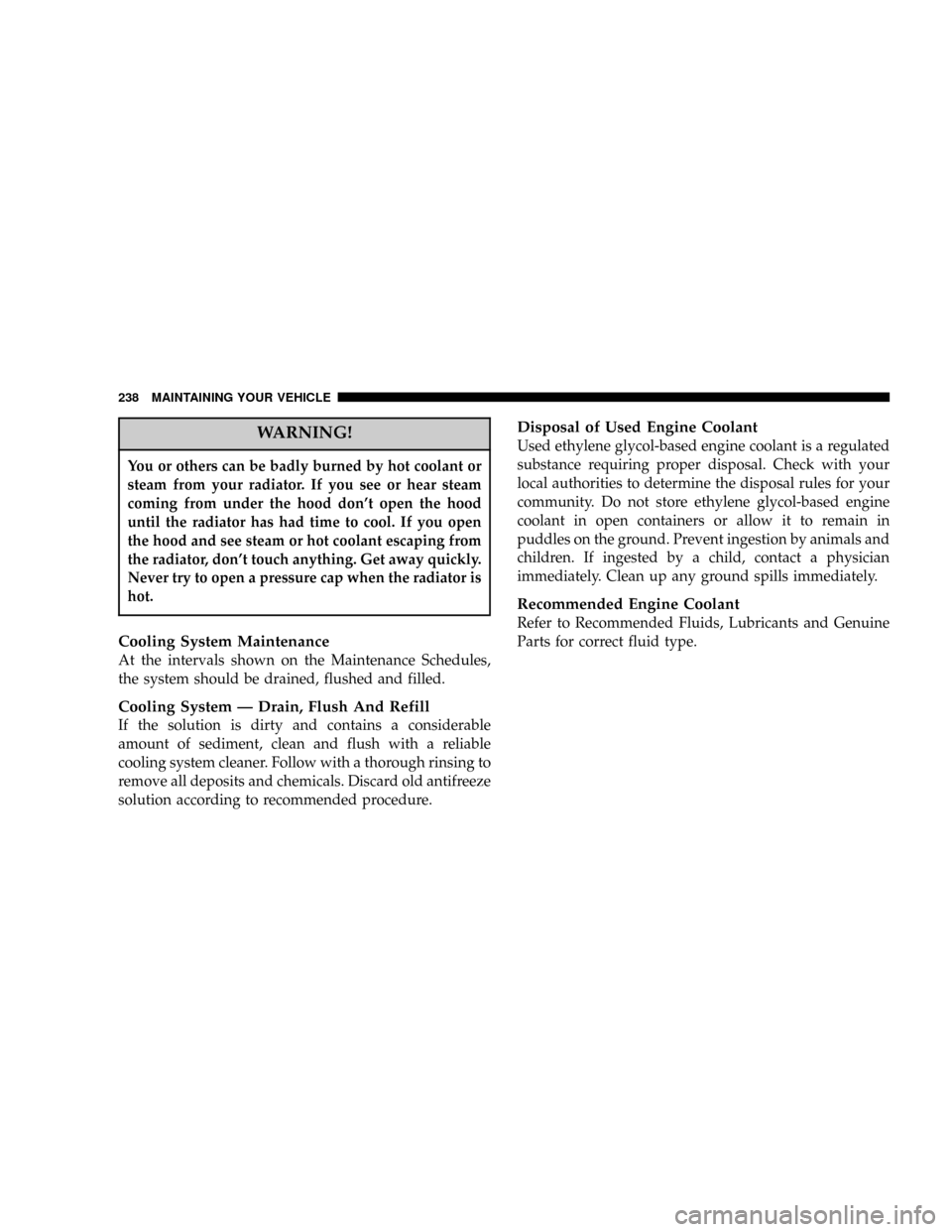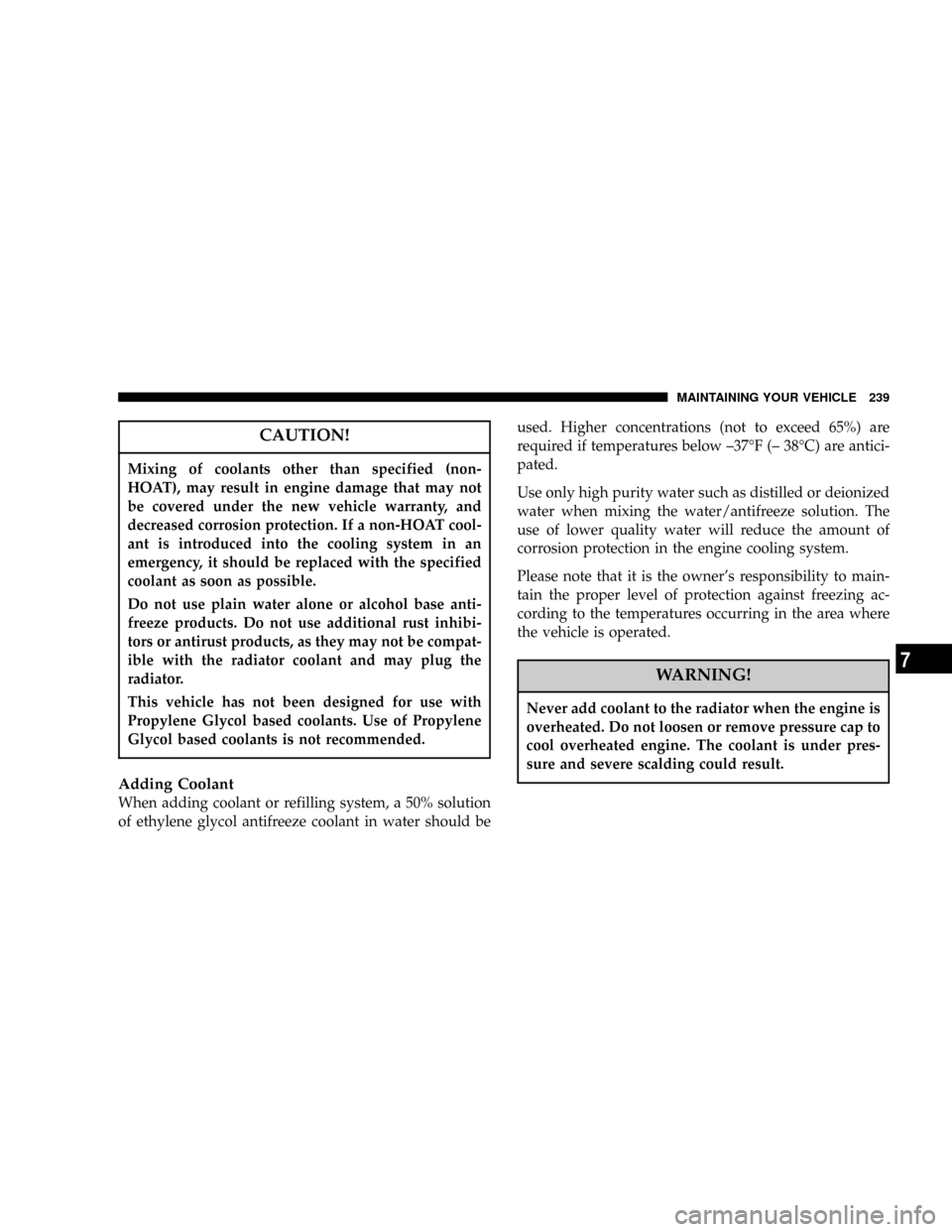2004 DODGE DAKOTA radiator
[x] Cancel search: radiatorPage 236 of 300

Operation of the wipers on dry glass for long periods
may cause deterioration of the wiper blades. Always use
washer fluid when using the wipers to remove salt or dirt
from a dry windshield.
Avoid using the wiper blades to remove frost or ice from
the windshield. Keep the blade rubber out of contact with
petroleum products such as engine oil, gasoline, etc.
Windshield Washers
The fluid reservoir should be checked for fluid level at
regular intervals. When freezing weather is anticipated,
flush out the water in the reservoir by operating the
system. Fill the reservoir with windshield washer anti-
freeze (not radiator antifreeze), and operate the system
for a few seconds to flush out the residual water.
To prevent freeze-up of your windshield washer system
in cold weather, select a solution or mixture that meets or
exceeds the temperature range of your climate. This
rating information can be found on most washer fluid
containers.
WARNING!
Commercially available windshield washer solvents
are flammable. They could ignite and burn you. Care
must be exercised when filling or working around
the washer solution.
After the engine has warmed, operate the defroster for a
few minutes to reduce the possibility of smearing or
freezing the fluid on the cold windshield. Mopar All
Weather Windshield Washer Solution used with water as
directed on the container, aids cleaning action, reduces
freezing point to avoid line clogging, and is not harmful
to paint or trim.
Exhaust System
The best protection against carbon monoxide entry into
the vehicle body is a properly maintained engine exhaust
system.
236 MAINTAINING YOUR VEHICLE
Page 237 of 300

Whenever a change is noticed in the sound of the exhaust
system, when exhaust fumes can be detected inside the
vehicle, or when the underside or rear of the vehicle is
damaged, have a competent mechanic inspect the com-
plete exhaust system and adjacent body areas for broken,
damaged, deteriorated, or mispositioned parts. Open
seams or loose connections could permit exhaust fumes
to seep into the passenger compartment. In addition,
inspect the exhaust system each time the vehicle is raised
for lubrication or oil change. Replace as required.
WARNING!
Exhaust gases can injure or kill. They contain carbon
monoxide (CO) which is colorless and odorless.
Breathing it can make you unconscious and can
eventually poison you. To avoid breathing CO, fol-
low the preceding safety tips.
Cooling System
Inspection
Coolant protection checks should be made at every 12
months (before the onset of freezing weather, where
applicable). If coolant is dirty or rusty in appearance, the
system should be drained, flushed and refilled with fresh
coolant. Check face of radiator for any accumulation of
bugs, leaves, etc. If dirty, clean the radiator core by gently
spraying water from a garden hose at the back of the core.
Check the reserve tank tubing for condition and tightness
of connection at reserve tank and radiator. Inspect the
entire system for leaks.
With the engine at normal operating temperature (but
not running), check the coolant pressure cap for proper
vacuum sealing by draining a small amount of coolant
from the radiator drain cock. If the cap is sealing prop-
erly, the coolant will begin to drain from the reserve tank.
Do not remove the pressure cap when the cooling system
is hot.
MAINTAINING YOUR VEHICLE 237
7
Page 238 of 300

WARNING!
You or others can be badly burned by hot coolant or
steam from your radiator. If you see or hear steam
coming from under the hood don't open the hood
until the radiator has had time to cool. If you open
the hood and see steam or hot coolant escaping from
the radiator, don't touch anything. Get away quickly.
Never try to open a pressure cap when the radiator is
hot.
Cooling System Maintenance
At the intervals shown on the Maintenance Schedules,
the system should be drained, flushed and filled.
Cooling System Ð Drain, Flush And Refill
If the solution is dirty and contains a considerable
amount of sediment, clean and flush with a reliable
cooling system cleaner. Follow with a thorough rinsing to
remove all deposits and chemicals. Discard old antifreeze
solution according to recommended procedure.
Disposal of Used Engine Coolant
Used ethylene glycol-based engine coolant is a regulated
substance requiring proper disposal. Check with your
local authorities to determine the disposal rules for your
community. Do not store ethylene glycol-based engine
coolant in open containers or allow it to remain in
puddles on the ground. Prevent ingestion by animals and
children. If ingested by a child, contact a physician
immediately. Clean up any ground spills immediately.
Recommended Engine Coolant
Refer to Recommended Fluids, Lubricants and Genuine
Parts for correct fluid type.
238 MAINTAINING YOUR VEHICLE
Page 239 of 300

CAUTION!
Mixing of coolants other than specified (non-
HOAT), may result in engine damage that may not
be covered under the new vehicle warranty, and
decreased corrosion protection. If a non-HOAT cool-
ant is introduced into the cooling system in an
emergency, it should be replaced with the specified
coolant as soon as possible.
Do not use plain water alone or alcohol base anti-
freeze products. Do not use additional rust inhibi-
tors or antirust products, as they may not be compat-
ible with the radiator coolant and may plug the
radiator.
This vehicle has not been designed for use with
Propylene Glycol based coolants. Use of Propylene
Glycol based coolants is not recommended.
Adding Coolant
When adding coolant or refilling system, a 50% solution
of ethylene glycol antifreeze coolant in water should beused. Higher concentrations (not to exceed 65%) are
required if temperatures below ±37ÉF (± 38ÉC) are antici-
pated.
Use only high purity water such as distilled or deionized
water when mixing the water/antifreeze solution. The
use of lower quality water will reduce the amount of
corrosion protection in the engine cooling system.
Please note that it is the owner's responsibility to main-
tain the proper level of protection against freezing ac-
cording to the temperatures occurring in the area where
the vehicle is operated.
WARNING!
Never add coolant to the radiator when the engine is
overheated. Do not loosen or remove pressure cap to
cool overheated engine. The coolant is under pres-
sure and severe scalding could result.
MAINTAINING YOUR VEHICLE 239
7
Page 240 of 300

Coolant Pressure Cap
The coolant pressure cap must be fully tightened to
prevent loss of coolant, and to insure that coolant will
return to the radiator from the coolant reserve tank.
The pressure cap should be inspected and cleaned if there
is any accumulation of foreign material on the sealing
surfaces.
WARNING!
The warning words ªDO NOT OPEN HOTº on the
coolant pressure cap are a safety precaution. Heat
causes pressure to build up in the cooling system. To
prevent scalding or injury, do not remove the pres-
sure cap when the system is hot or under pressure.
Coolant Level
The coolant reserve system provides a quick visual
method for determining that the coolant level is ad-
equate. With the engine idling, and warmed to normal
operating temperature, remove the cap from the over-
flow bottle, remove the dipstick and wipe the excess
coolant from it. Reinsert the dipstick and remove. Ob-
serve the dipstick checking the holes along the stem for
coolant. Check the coolant level whenever the hood is
raised.
240 MAINTAINING YOUR VEHICLE
Page 241 of 300

The radiator normally remains completely full, so there is
no need to remove the pressure cap except when check-
ing coolant freeze point or when replacing coolant. Your
service attendant should be advised of this. When addi-
tional coolant is needed to maintain the proper level, it
should be added to the overflow bottle. Do not overfill.
Points To Remember
A. Do not overfill the reserve tank (overflow bottle).
B. Check coolant freeze point in the radiator and in the
reserve tank. If antifreeze needs to be added, contents of
reserve tank also must be protected against freezing.
C. If frequent coolant additions are required, or if the
level in the reserve tank does not drop when the engine
cools, the cooling system should be pressure tested for
leaks.D. Maintain a minimum coolant concentration of 50%
ethylene glycol.
E. Make sure that the radiator and reserve tank overflow
hoses are not kinked or obstructed.
F. Keep the front of the radiator clean. If your vehicle is
equipped with air conditioning, keep the front of the
condenser clean also.
G. The thermostat should not be changed for summer or
winter operation. If replacement is ever necessary, install
ONLY the correct type thermostat. Other designs may
result in unsatisfactory cooling performance.
Emission Related Components
Fuel System Hoses And Vapor/Vacuum Harnesses
When the vehicle is serviced for scheduled maintenance,
inspect surface of hoses and nylon tubing for evidence of
heat and mechanical damage. Hard and brittle rubber,
cracking, checking, tears, cuts, abrasions, and excessive
swelling suggest deterioration of the rubber. Particular
attention should be given to examining hose surfaces
nearest to high heat sources, such as the exhaust mani-
fold.
MAINTAINING YOUR VEHICLE 241
7
Page 290 of 300

Compact Disc Maintenance............... 132
Compact Disc Player.................106,110
Compact Spare Tire..................... 178
Compass.............................. 79
Compass Calibration...................79,80
Computer, Trip/Travel.................... 77
Console, Floor.......................... 88
Console, Overhead....................... 76
Contract, Service....................... 282
Converter, Catalytic..................... 189
Coolant Pressure Cap.................... 240
Cooling System.....................237,240
Adding Coolant (Antifreeze)............. 239
Coolant Capacity..................... 258
Coolant Level........................ 240
Disposal of Used Coolant............... 238
Drain, Flush, and Refill................. 238
Inspection........................... 237
Points to Remember................... 241
Radiator Cap........................ 240
Selection of Coolant.............238,258,259
Temperature Gauge.................... 99
Cruise Control.......................... 74Cruise Light........................... 104
Cup Holder............................ 89
Customer Assistance.................... 280
Daytime Running Lights.................. 69
Dealer Service......................... 225
Defroster, Rear Window.................. 140
Defroster, Windshield...............54,133,136
Delay Wipers........................... 71
Diagnostic System, Onboard............... 223
Differential, Limited-Slip................. 162
Dimmer Switch, Headlight................ 100
Dipsticks
Automatic Transmission................ 245
Oil (Engine)......................... 226
Power Steering....................... 234
Disabled Vehicle Towing................. 217
Disc Brakes........................... 243
Disposal
Used Coolant........................ 238
Door Ajar............................ 103
Door Locks..........................13,14
Door Opener, Garage..................... 81
290 INDEX
Page 296 of 300

Viscosity.........................228,258
Onboard Diagnostic System............223,224
Opener, Garage Door..................... 81
Outside Rearview Mirrors................. 59
Overdrive............................ 148
Overhead Console.....................76,77
Overhead Travel Information Center......... 77
Overheating, Engine..................104,239
Owner's Manual....................... 284
Panic Alarm........................... 19
Parking Brake......................... 163
Parking On Hill........................ 163
Passenger Airbag On/Off Switch............ 34
Passing Light........................... 70
Pickup Box........................... 194
Placard, Tire and Loading Information....... 172
Positive Crankcase Valve................. 242
Power
Brakes............................. 243
Distribution Center.................... 252
Door Locks.......................... 14
Mirrors............................. 60Outlet.............................. 86
Steering.........................166,234
Windows............................ 22
Power Steering Fluid.................... 260
Pregnant Women and Seat Belts............. 30
Pressure Gauge, Oil..................... 100
Programmable Electronic Features.........82,85
Programming Transmitters............19,82,85
Quad Cab............................. 65
Radial Ply Tires........................ 178
Radiator Cap.......................... 240
Radio.......................106,114,119,124
Radio Operation.................. 114,119,132
Rear Axle............................. 248
Rear Window Defroster.................. 140
Rearview Mirrors........................ 58
Reclining Front Seats..................... 62
Recommended Fluids, Lubricants and Genuine
Parts............................... 259
Recreational Towing..................... 202
Shifting into Transfer Case Neutral (N)..... 202
296 INDEX